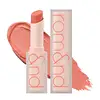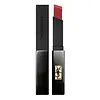What's inside
What's inside
 Key Ingredients
Key Ingredients

 Benefits
Benefits

 Concerns
Concerns

 Ingredients Side-by-side
Ingredients Side-by-side

Dimethicone
EmollientIsoamyl Laurate
EmollientDiisostearyl Malate
EmollientDiphenyl Dimethicone/Vinyl Diphenyl Dimethicone/Silsesquioxane Crosspolymer
CI 77891
Cosmetic ColorantIsononyl Isononanoate
EmollientVinyl Dimethicone/Methicone Silsesquioxane Crosspolymer
Polyethylene
AbrasiveIsoeicosane
EmollientEthylhexyl Hydroxystearate
EmollientSilica
AbrasiveHydrogenated Polyisobutene
EmollientPolyglyceryl-2 Triisostearate
EmulsifyingMicrocrystalline Wax
Emulsion StabilisingDimethicone Crosspolymer
Emulsion StabilisingParaffin
PerfumingDiglyceryl Sebacate/Isopalmitate
EmollientCI 77492
Cosmetic ColorantCI 77491
Cosmetic ColorantSodium Hyaluronate
HumectantGossypium Herbaceum Seed Extract
Skin ConditioningSorbitan Isostearate
EmulsifyingVp/Hexadecene Copolymer
Polyhydroxystearic Acid
EmulsifyingTriethoxycaprylylsilane
Polyglyceryl-2 Diisostearate
EmulsifyingEthylhexyl Palmitate
EmollientIsopropyl Myristate
EmollientIsostearic Acid
CleansingLecithin
EmollientPolyglyceryl-3 Polyricinoleate
EmulsifyingPentaerythrityl Tetra-Di-T-Butyl Hydroxyhydrocinnamate
AntioxidantButylene Glycol
HumectantWater
Skin ConditioningGlycerin
HumectantSilica Dimethyl Silylate
EmollientCaprylyl Glycol
EmollientHexylene Glycol
EmulsifyingPhenoxyethanol
PreservativeCI 19140
Cosmetic ColorantCI 15850
Cosmetic ColorantCI 45410
Cosmetic ColorantCI 77499
Cosmetic ColorantDimethicone, Isoamyl Laurate, Diisostearyl Malate, Diphenyl Dimethicone/Vinyl Diphenyl Dimethicone/Silsesquioxane Crosspolymer, CI 77891, Isononyl Isononanoate, Vinyl Dimethicone/Methicone Silsesquioxane Crosspolymer, Polyethylene, Isoeicosane, Ethylhexyl Hydroxystearate, Silica, Hydrogenated Polyisobutene, Polyglyceryl-2 Triisostearate, Microcrystalline Wax, Dimethicone Crosspolymer, Paraffin, Diglyceryl Sebacate/Isopalmitate, CI 77492, CI 77491, Sodium Hyaluronate, Gossypium Herbaceum Seed Extract, Sorbitan Isostearate, Vp/Hexadecene Copolymer, Polyhydroxystearic Acid, Triethoxycaprylylsilane, Polyglyceryl-2 Diisostearate, Ethylhexyl Palmitate, Isopropyl Myristate, Isostearic Acid, Lecithin, Polyglyceryl-3 Polyricinoleate, Pentaerythrityl Tetra-Di-T-Butyl Hydroxyhydrocinnamate, Butylene Glycol, Water, Glycerin, Silica Dimethyl Silylate, Caprylyl Glycol, Hexylene Glycol, Phenoxyethanol, CI 19140, CI 15850, CI 45410, CI 77499
Dimethicone
EmollientBis-Diglyceryl Polyacyladipate-2
EmollientHydrogenated Polyisobutene
EmollientTridecyl Trimellitate
EmollientPhenyl Trimethicone
Skin ConditioningIsohexadecane
EmollientCI 15985
Cosmetic ColorantHydrogenated Jojoba Oil
AbrasiveDimethicone Crosspolymer
Emulsion StabilisingIsostearyl Isostearate
EmollientParaffin
PerfumingMethylsilanol/Silicate Crosspolymer
Skin ConditioningCera Microcristallina
Emulsion StabilisingKaolin
AbrasiveMica
Cosmetic ColorantVinyl Dimethicone/Methicone Silsesquioxane Crosspolymer
Nylon-12
Polyethylene
AbrasiveCI 15850
Cosmetic ColorantSynthetic Wax
AbrasiveCI 77491
Cosmetic ColorantTriethoxysilylethyl Polydimethylsiloxyethyl Dimethicone
Skin ConditioningIsopropyl Titanium Triisostearate
EmollientCI 77499
Cosmetic ColorantPentaerythrityl Tetra-Di-T-Butyl Hydroxyhydrocinnamate
AntioxidantBenzyl Alcohol
PerfumingLimonene
PerfumingWater
Skin ConditioningPropanediol
SolventBenzyl Benzoate
AntimicrobialAnise Alcohol
PerfumingTocopherol
AntioxidantPelargonium Graveolens Extract
MaskingParfum
MaskingAlumina
AbrasiveDimethicone, Bis-Diglyceryl Polyacyladipate-2, Hydrogenated Polyisobutene, Tridecyl Trimellitate, Phenyl Trimethicone, Isohexadecane, CI 15985, Hydrogenated Jojoba Oil, Dimethicone Crosspolymer, Isostearyl Isostearate, Paraffin, Methylsilanol/Silicate Crosspolymer, Cera Microcristallina, Kaolin, Mica, Vinyl Dimethicone/Methicone Silsesquioxane Crosspolymer, Nylon-12, Polyethylene, CI 15850, Synthetic Wax, CI 77491, Triethoxysilylethyl Polydimethylsiloxyethyl Dimethicone, Isopropyl Titanium Triisostearate, CI 77499, Pentaerythrityl Tetra-Di-T-Butyl Hydroxyhydrocinnamate, Benzyl Alcohol, Limonene, Water, Propanediol, Benzyl Benzoate, Anise Alcohol, Tocopherol, Pelargonium Graveolens Extract, Parfum, Alumina
Ingredients Explained
These ingredients are found in both products.
Ingredients higher up in an ingredient list are typically present in a larger amount.
Ci 15850 is the pigment color red. It is an azo dye and created synthetically.
Azo dyes need to be thoroughly purified before use. This allows them to be more stable and longer-lasting.
This ingredient is common in foundations, lipsticks, and blushes. This color is described as brown/orangey red.
It has many secondary names such as Red 6 and Red 7. According to a manufacturer, Red 6 usually contains aluminum.
Learn more about CI 15850Ci 77491 is also hydrated iron III oxide. It's sole purpose is to give a red/pink hue to products.
Iron III oxides are classified as inorganic chemicals for coloring.
Synthetically created Ci 77491 is considered safer than those naturally found. This is because the synthetically created version may contain less impurities. Iron oxides are generally non-toxic and non-allergenic.
Learn more about CI 77491Ci 77499 is also hydrated iron III oxide. It is created from mixing red and black iron oxides. This helps give shades of darkness to a product.
Iron III oxides are classified as inorganic chemicals for coloring.
Dimethicone is a type of synthetic silicone created from natural materials such as quartz.
What it does:
Dimethicone comes in different viscosities:
Depending on the viscosity, dimethicone has different properties.
Ingredients lists don't always show which type is used, so we recommend reaching out to the brand if you have questions about the viscosity.
This ingredient is unlikely to cause irritation because it does not get absorbed into skin. However, people with silicone allergies should be careful about using this ingredient.
Note: Dimethicone may contribute to pilling. This is because it is not oil or water soluble, so pilling may occur when layered with products. When mixed with heavy oils in a formula, the outcome is also quite greasy.
Learn more about DimethiconeDimethicone Crosspolymer is a silicone created by modifying dimethicone with hydrocarbon side chains. Due to its large size, it does not penetrate skin. It is considered non-occlusive.
Dimethicone Crosspolymer is used to stabilize and thicken products. It also helps give products a silky feel.
Hydrogenated Polyisobutene is a synthetic polymer. Polymers are compounds with high molecular weight. Hydrogenated Polyisobutene is an emollient and texture enhancer.
In one study, Hydrogenated Polyisobutene showed better skin hydration levels than Caprylic/Capric Triglyceride. As an emollient, it helps keep your skin soft and hydrated by trapping moisture in.
Hydrogenated Polyisobutene is often used as a mineral oil replacement.
Learn more about Hydrogenated PolyisobuteneParaffin is a solid created from petroleum. The term 'paraffin' can also refer to either
petroleum jelly or mineral oil.
It has natural occlusive properties which can worsen oily skin. Due to its petrolatum base, this ingredient is not fungal-acne safe.
Pentaerythrityl Tetra-Di-T-Butyl Hydroxyhydrocinnamate (long name, huh?) is a synthetic antioxidant.
It is used to help stabilize other antioxidants or prevent the color from changing in a product.
As an antioxidant, it helps fight free-radical molecules. Free-radical molecules are capable of damaging our cells and other genetic material. Thus, antioxidants may reduce the signs of aging.
This ingredient is oil-soluble.
Learn more about Pentaerythrityl Tetra-Di-T-Butyl HydroxyhydrocinnamatePolyethylene is a synthetic ingredient that helps the skin retain moisture. It is a polymer.
It is also typically used within product formulations to help bind solid ingredients together and thicken oil-based ingredients. When added to balms and emulsions, it helps increase the melting point temperature.
This ingredient is used in makeup and skincare to thicken formulas, reduce shine, and give skin a silky-smooth feel.
It’s a white silicone powder that sits in fine lines and pores to blur their appearance though its effectiveness depends on the particle size.
You'll typically find this ingredient in amounts between 0.1-20%.
Learn more about Vinyl Dimethicone/Methicone Silsesquioxane CrosspolymerWater. It's the most common cosmetic ingredient of all. You'll usually see it at the top of ingredient lists, meaning that it makes up the largest part of the product.
So why is it so popular? Water most often acts as a solvent - this means that it helps dissolve other ingredients into the formulation.
You'll also recognize water as that liquid we all need to stay alive. If you see this, drink a glass of water. Stay hydrated!
Learn more about Water